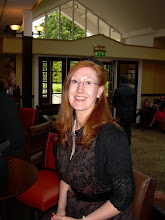 Since my knowledge of Dame Laura Knight's painting has been limited to her self-portrait at the NPG and some reproductions in a biography of her which I recently read, I've been really looking forward to the exhibition at Nottingham Castle on her theatre paintings, and it didn't disappoint. There are two fairly large rooms of her work, mostly of her ballet paintings but also some theatre and one or two theatrical portraits. Clearly she liked to paint people - interesting people, or people doing interesting things, and her sense of the dramatic comes across in all her work. She had an enormous output, painting circus people at work, being official artist for the Nuremburg trials and commissions by the government during the Second World War, among other things, but her paintings are all very much of their time - her career pretty much spanned her life (1877
Since my knowledge of Dame Laura Knight's painting has been limited to her self-portrait at the NPG and some reproductions in a biography of her which I recently read, I've been really looking forward to the exhibition at Nottingham Castle on her theatre paintings, and it didn't disappoint. There are two fairly large rooms of her work, mostly of her ballet paintings but also some theatre and one or two theatrical portraits. Clearly she liked to paint people - interesting people, or people doing interesting things, and her sense of the dramatic comes across in all her work. She had an enormous output, painting circus people at work, being official artist for the Nuremburg trials and commissions by the government during the Second World War, among other things, but her paintings are all very much of their time - her career pretty much spanned her life (1877 -1960, I think) and she manifestly moved with the times, remaining contemporary and vital, never stale or boring. I can't remember when I last enjoyed something visually so much as this.
-1960, I think) and she manifestly moved with the times, remaining contemporary and vital, never stale or boring. I can't remember when I last enjoyed something visually so much as this.The ballet paintings are bound to appeal to me, since I have a passing interest in ballet, but I am somewhat sceptical of the prettified 1950s paintings of the ballet; a few here were reminiscent of them, but in the 1930s, before it became a cliche, and they're beautiful. Moreover, she knows dancers, and dancing - she paints them not just performing, but in class, in the dressing room, in the wings, and she gets the angles of their bodies exactly right - legend has it that when she painted dancers in class the teacher would use her sketches to show the dancers what they had done wrong!

The exhibition is a mixture of sketches and oil paintings, and both are a delight, but in very different ways. The technical skill, the colours and vitality of the oils appealed to me, but her ability to catch a dancer's poise and movement in a few lines in her sketches is amazing. Her love of the theatrical life shines through her work. To get an idea of the breadth of her work, there are some examples of her work here. Interestingly, she is often described as an Impressionist painter, but I'm inclined to disagree with this, since her work changes medium and styles, with some of the oils - for example, the painting of Gwen Ffrangcon-Davies as Juliet - seeming almost Pre-Raphaelite in style. However, such labels aren't helpful; her subjects, not her style, was clearly her own preoccupation.
A critic of one of her exhibitions during the 1960s suggested that she painted what she saw, not what she felt - that her work wasn't cerebral enough, perhaps. For the viewer, I think it's difficult to disentangle seeing and feeling anyway, and these paintings are a visual delight; I found myself smiling as I looked at them. There isn't one painting there I wouldn't have liked to take home with me, and her joy in the visual, in the nature of spectacle, is enough for me; I don't really want to analyse it, just enjoy it (which is unlike me!)
An exhibition which will include some of Knight's work is coming to one of my favourite small galleries, Penlee House, later this year, and I shall definitely be going to see it.











No comments:
Post a Comment